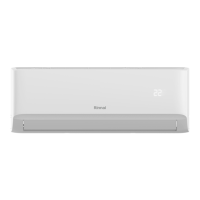Air Evacuation
Preparations and Precautions
Air and foreign matter in the refrigerant circuit can
cause abnormal rises in pressure, which can damage
the air conditioner, reduce its efficiency, and cause
injury. Use a vacuum pump and manifold gauge to
evacuate the refrigerant circuit, removing any
non-condensable gas and moisture from the system.
Evacuation should be performed upon initial
installation and when unit is relocated.
8. Insert hexagonal wrench into the packed valve
(high pressure valve) and open the valve by
turning the wrench 1/4 counterclockwise.
Listen for gas to exit the system, then close the
valve after 5 seconds.
Flare nut
BEFORE PERFORMING EVACUATION
Cap
Valve body
Valve stem
Evacuation Instructions
Before using a manifold gauge and a vacuum
pump, read their operation manuals to make
sure you know how to use them properly.
Manifold Gauge
Compound gauge
Pressure gauge
OPEN VALVE STEMS GENTLY
-100 kPa
When opening valve stems, turn the hexagonal
wrench until it hits against the stopper. DO NOT
try to force the valve to open further.
Low pressure valve
Charge hose
High pressure valve
Charge hose
12.
After opening up the service valve stems to allow
please apply leak search solution to ensure the
service valve spindles are not leaking.
if service valve spindles are leaking front and
back seat them several times to readjust the seal
behind the valve stem.
before service valve caps are placed onto the
service valves.
Vacuum pump
Low pressure valve
13. Tighten valve caps by hand, then tighten it
using the proper tool.
If the outdoor unit uses all vacuum valves,
and the vacuum position is at the main valve,
the system is not connected with the indoor
unit. The valve must be tightened with a
screw nut. Check for gas leaks before
operation to prevent leakage.
After removing your refrigeration gauges of the
system please apply leak search solution to
ensure the schrader valve cores are not leaking.
before schrader valve caps are placed onto the
service valves ports.
14.
15.
NOTE: If there is no change in system pressure,
unscrew the cap from the packed valve (high
pressure valve). If there is a change in system
pressure, there may be a gas leak.
Check to make sure the connective pipes
between the indoor and outdoor units
are connected properly .
Check to make sure all wiring is connected
9. Watch the Pressure Gauge for one minute to make
sure that there is no change in pressure. It should
read slightly higher than the atmospheric pressure.
10.Remove the charge hose from the service port.
11. Using hexagonal wrench, fully open both the
high pressure and low pressure valves.
1. Connect the manifold gauge’s charge hose
to the service port on the outdoor unit’s low
pressure valve.
2. Connect the manifold gauge’s charge hose
from the to the vacuum pump.
3. Open the Low Pressur e side of the manifold
gauge. Keep the High Pressure side closed.
4. Turn on the vacuum pump to evacuate the
system.
5. Run the vacuum for at least 30 minutes, or
until the Compound Meter reads -100 kPa.
6. Close the manifold gauge’s Low Pressure
valve and turn off the vacuum pump.
7. Wait for 5 minutes, then check that ther e has
been no change in system pressure.
Note On Adding Refrigerant
CAUTION
• Refrigerant charging must be performed after wiring, vacuuming, and the leak testing.
• DO NOT exceed the maximum allowable quantity of refrigerant or overcharge the system.
Doing so can damage the unit or impact it’s functioning.
• Charging with unsuitable substances may cause explosions or accidents. Ensure that the
appropriate refrigerant is used.
Refrigerant containers must be opened slowly. Always use protective gear when charging the
system.
•
• DO NOT mix refrigerants types.
ADDITIONAL REFRIGERANT PER PIPE LENGTH
Air Evacuation
• For R32 refrigerant model, make sure the conditions within the area have been made
NOTE:
The standard pipe length is 10m.
N=3 (3 Head models), N=4 (4 Head models), N=5 (5 Head models).
Depending on the length of connective piping or the pressure of the evacuated system, you
may need to add refrigerant. Refer to table below for refrigerant amounts to be added:
Connective Pipe
Length(m)
Air Purging
Method
Additional Refrigerant (R32)
Less than
Standard pipe length x N
Vacuum Pump
N/A
More than
Standard pipe length x N
Vacuum Pump
Make sure to remove the additional refrigerant charge according to the rated volume (5m
refrigerant piping) when doing market or government verication test.
Liquid Side: Ø 9.52 (mm)
(Total pipe length - pre-charge pipe lengthxN) x30g/m
Liquid Side: Ø 6.35 (mm)
(Total pipe length - pre-charge pipe lengthxN) x15g/m

